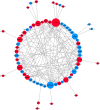Epithelial cell senescence: an adaptive response to pre-carcinogenic stresses?
- PMID: 28707011
- PMCID: PMC11107641
- DOI: 10.1007/s00018-017-2587-9
Epithelial cell senescence: an adaptive response to pre-carcinogenic stresses?
Abstract
Senescence is a cell state occurring in vitro and in vivo after successive replication cycles and/or upon exposition to various stressors. It is characterized by a strong cell cycle arrest associated with several molecular, metabolic and morphologic changes. The accumulation of senescent cells in tissues and organs with time plays a role in organismal aging and in several age-associated disorders and pathologies. Moreover, several therapeutic interventions are able to prematurely induce senescence. It is, therefore, tremendously important to characterize in-depth, the mechanisms by which senescence is induced, as well as the precise properties of senescent cells. For historical reasons, senescence is often studied with fibroblast models. Other cell types, however, much more relevant regarding the structure and function of vital organs and/or regarding pathologies, are regrettably often neglected. In this article, we will clarify what is known on senescence of epithelial cells and highlight what distinguishes it from, and what makes it like, replicative senescence of fibroblasts taken as a standard.
Keywords: Aging; Autophagy; Cancer; DNA damage; DSB; Keratinocytes; Mammary epithelial cells; Oxidative stress; PARP1; Proteostasis; SASP; SSB; Unfolded protein response; p16; p38MAPK; p53.
Conflict of interest statement
The authors declare that they have no conflict of interest.
Figures



References
Publication types
MeSH terms
LinkOut - more resources
Full Text Sources
Other Literature Sources
Research Materials
Miscellaneous

